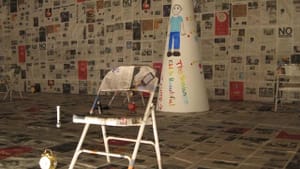Stay in the Loop
BSR publishes on a weekly schedule, with an email newsletter every Wednesday and Thursday morning. There’s no paywall, and subscribing is always free.
An elusive view
Christopher Knowles: In a Word at ICA

This exhibit reminds me of The Emperor’s New Clothes. I can’t see the art.
Christopher Knowles, 56, has been creating poetry, and spoken, visual, and performance art pieces for more than 40 years. Diagnosed as autistic in childhood, he learned to speak by memorization and repetition: Many of the pieces are constructed from word groups and sound-alikes, as in Block Clock Rock (2011), and reflect this experience. Knowles’s early work, in particular, grew out of therapeutic exercises and focus on daily routines, such as making lists (The Pauls, 1984), and revising pop lyrics — George Harrison’s Give Me Love (Give Me Peace on Earth) became (Give Me Love) Give Me Piece on Earth (1976).
Christopher Knowles: In a Word, currently at Penn’s Institute of Contemporary Art, opens with What I Do on a Typical Day (2011), a typewritten half-page of short sentences such as “I brush my teeth. I go to the office. I open up the mail.”
A range of media is represented, from audio collages of poems such as Emily Likes the TV (1973), a spare vocal describing his sister’s viewing habits in simple sentences, to photographs of bare hangers and motel room furnishings, to paintings (The Cow Drawing, 1985), and correspondence (Dear George, 1979).
From poems to performance
When Knowles was just 13, a tape of Emily brought him to the attention of experimental theater director Robert Wilson, who commented in a New Yorker interview that he didn’t understand the piece, but sensed mathematical patterns in the words. On the strength of that intuition, Wilson cast Knowles in The Life and Times of Joseph Stalin. The two collaborated frequently over the next decade, most notably Einstein on the Beach (1976), an opera composed by Philip Glass. Knowles’s poems were used in the libretto.

A large section of the exhibition is occupied by The Sundance Kid Is Beautiful, (2013-2015) an installation and performance piece in which several strands of Knowles’s artistic identity combine. Sundance is two stories tall, papered with pages from the New York Times, and furnished with alarm clocks, cassette players, folding chairs, and cones. Light in the space shifts continually from full brightness to complete darkness while an audio loops a pastiche of Emily Likes the TV and Knowles’s rendering of the story of Scheherazade, “Every night Scheherazade tells the king a new story. . . .Her stories have no ending.”
The installation becomes a stage when Knowles performs Sundance, described as a work in progress. Sundance has been performed twice at ICA, as well as at the University of Rochester last October, and in 2013 at the Louvre.
Elusive typings
In a Word includes numerous examples of Knowles’s “Typings” series, for which he is widely known. The works include typewriter-produced drawings (picture tall skyscrapers with lots of windows, formed from hundreds of lowercase “c”s and white space). In the case of C (red and black), and C (white and black), both made in 1975, pages are covered edge-to-edge with a single letter, typed over and over.

Compiled as a book in 1979, the “Typings” are difficult to accept as art. For example, Long Long Chain Typing (1981) is a tower of “c”s in red and black. Untitled (E and ING lists, 1974), like many Typings, features columns of words such as “Giggle, ache, and freeze” on the left, corresponding to “giggling, aching, freezing” on the right. They look like creative writing homework.
Prestigious recognition
And Dance (2011) looks like writer’s block: the word “dance,” typed 14 times. Though their significance eludes me, works in the Typings series are held by the Museum of Modern Art, the Brooklyn Museum, Rotterdam’s Boymans van Beuningen Museum, as well as private collectors.
In 2013, Knowles was recognized with a Wynn Newhouse Award grant, established by the Samuel I. Newhouse Foundation to acknowledge “artists of excellence who happen to have a disability.”
The ICA exhibition includes a few drawings and paintings, which provide a more discernable sense of the person behind them. Along with Knowles’s handwritten notes and cards (SEK 22nd Birthday, 1982), these renderings have color, exuberance, and humor that enable one a sense, at least, of where the artist is coming from — something lacking in much of the exhibit.
The vision thing
In considering Knowles’s work, everything comes back to vision. His way of seeing and responding to the world is inarguably shaped by physical and mental characteristics; in this, Knowles is like any artist, or for that matter, any person. Yet Robert Wilson, who is called a visionary, saw art in Knowles’s expressions, a view that has since been joined by collaborators, curators, and collectors.
I, however, see differently.
What, When, Where
Christopher Knowles: In a Word. Through December 27, 2015 at Institute of Contemporary Art, University of Pennsylvania, 118 South 36th Street, Philadelphia. 215-898-7108 or icaphila.org.
Sign up for our newsletter
All of the week's new articles, all in one place. Sign up for the free weekly BSR newsletters, and don't miss a conversation.